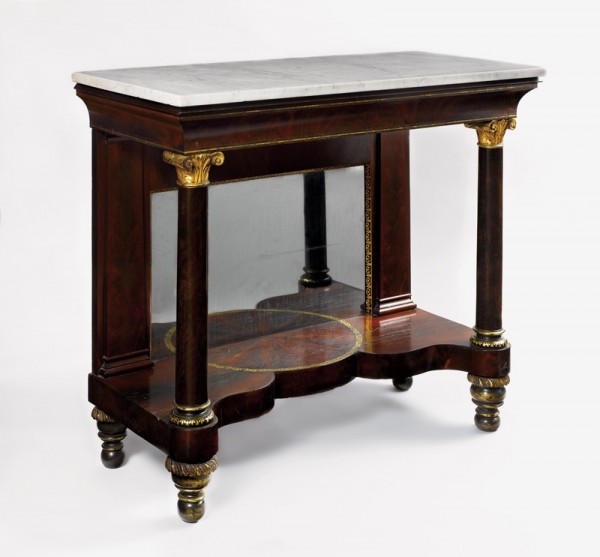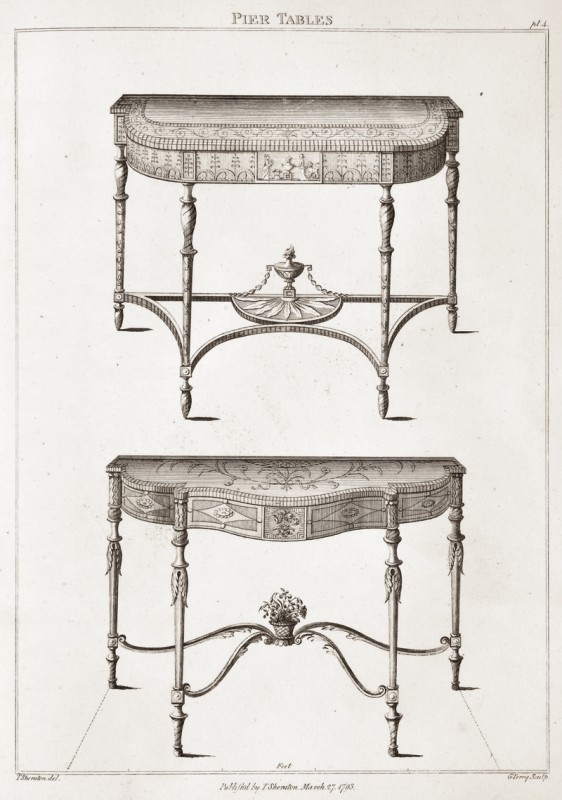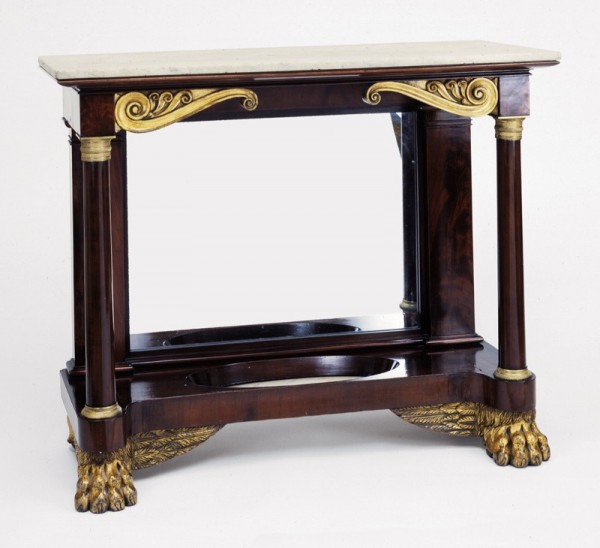
Pier table, Philadelphia, Pennsylvania, 1825–1835. Mahogany with tulip poplar and white pine; marble, glass. H. 37", W. 42" D. 20". (Courtesy, Aileen Minor Antiques.)

Pier table, Philadelphia, Pennsylvania, 1825–1835. Mahogany with unrecorded secondary woods; marble, glass. H. 39" W. 42" D. 20". (© Christie’s Images Limited [2006].)

Pier table labeled by Michael Allison, New York City, 1816–1825. Rosewood with tulip poplar; brass, marble, glass. H. 37" W. 40" x D. 20". (Courtesy, Winterthur Museum.)

Pier table, New York City, 1820–1830. Rosewood with white pine; marble, glass. H. 39", W. 44", D. 19". (Courtesy, Winterthur Museum.)

Composite illustration showing, (a) Crispijn van de Passe, Oficina Arcularia (Amsterdam, 1642) pl. 17 (Courtesy, Winterthur Library: Printed Book and Periodical Collection); (b) detail of the support on the pier table illustrated in fig. 30; (c) George Smith, Ornamental Designs (London, ca. 1812), pl. 30 (Courtesy, Winterthur Library: Printed Book and Periodical Collection); (d) William Smee and Sons, Designs of Furniture (London, ca. 1840), pl. 86 (Courtesy, Winterthur Library: Printed Book and Periodical Collection).

Pier table, Philadelphia, Pennsylvania, 1820–1830. Mahogany with tulip poplar; marble, glass. H. 38", W. 34", D. 17 1/2". (Courtesy, Historical Society of Delaware, permanent collection; photo, Gavin Ashworth.)

Pier table bearing the label of Anthony G. Quervelle, Philadelphia, Pennsylvania, 1825–1829. Mahogany with tulip poplar; brass, marble, glass. H. 37 3/4", W. 48", D. 22". (Courtesy, Athenaeum of Philadelphia.)

The Family of John Q. Aymar, attributed to George W. Twibill, New York City, ca. 1833. Oil on canvas. 30" x 40". (Private collection; photo, Gavin Ashworth.) No period images of a Philadelphia pier table in situ are known. In this New York interior, the pier table and the fireplace surround share complementary features such as gilt Ionic capitals. John Q. Aymar was a prominent China trade merchant; the ship masts in the distance symbolize the source of his family’s wealth and social standing.

Design for a pier table in Jean le Pautre, Livre de miroirs, tables et gueridons (Paris, ca. 1660), pl. 3. (Courtesy, Winterthur Library: Printed Book and Periodical Collection.)

Pier table attributed to William Buckland and William Bernard Sears, Richmond County, Virginia, 1761–1771. Cherry with beech; marble. H. 31 1/4", W. 45 3/8", D. 29 3/4". (Courtesy, Colonial Williamsburg Foundation; photo, Gavin Ashworth.)

Sideboard table attributed to William Buckland and William Bernard Sears, Richmond County, Virginia, 1761–1771. Walnut; marble. H. 35", W. 42 1/2", D. 25 1/2". (Collection of the Museum of Early Southern Decorative Arts, Old Salem Museums & Gardens; photo, Gavin Ashworth.)

Pier or side table, carving attributed to Nicholas Bernard and Martin Jugiez, Philadelphia, Pennsylvania ca. 1765. Mahogany; marble. H. 34", W. 66", D. 30". (Courtesy, Philadelphia Museum of Art, purchased with the J. Stogdell Stokes Fund and the John D. McIlhenny Fund, 1953; photo, Gavin Ashworth.)

Pier table, Philadelphia, Pennsylvania, 1767–1770. Mahogany with yellow pine and walnut; marble. H. 32 3/8", W. 48 1/4", D. 23 1/4". (Courtesy, Metropolitan Museum of Art, John Stewart Kennedy Fund, 1918 [18.110.27]; photo, Gavin Ashworth, Image © Metropolitan Museum of Art.)

Designs for pier tables in Thomas Sheraton, The Cabinet-Maker and Upholsterer’s Drawing-Book (London, 1793), pl. 4. (Courtesy, Winterthur Library: Printed Book and Periodical Collection.)

Designs for pier tables in George Hepplewhite, The Cabinet-Maker and Upholsterer’s Guide, 3rd ed. (London, 1794), pl. 65. (Courtesy, Winterthur Library: Printed Book and Periodical Collection.)

Detail of pier table in Pierre de La Mésangère, Collection de meubles et objets de goût (Paris, 1802), pl. 10. (Courtesy, Metropolitan Museum of Art, Harris Brisbane Dick Fund, 1930 [30.80], Image © Metropolitan Museum of Art).

Pier table illustrated on plate 17 in Rudolph Ackermann, The Repository of Arts, Literature, Commerce, Manufactures, Fashion and Politics (September 1828). (Courtesy, Winterthur Library: Printed Book and Periodical Collection.)

Pier table bearing the label of Joseph B. Barry & Son, Philadelphia, Pennsylvania, 1810–1815. Mahogany, satinwood, and amboina with tulip poplar and white pine; brass, marble, glass. H. 38", W. 54", D. 24". (Courtesy, Metropolitan Museum of Art, Friends of the American Wing Fund, Anonymous gift, George M. Kaufman gift, Sansbury-Mills Fund, gifts of the Committee of the Bertha King Benkard Memorial Fund, Mrs. Russell Sage, Mrs. Frederick Wildman, F. Ethel Wickham, Edgar William and Bernice Chrysler Garbisch, and Mrs. F. M. Townsend by exchange; and John Stewart Kennedy Fund and bequests of Martha S. Tiedeman and W. Gedney Beatty by exchange, 1976 [1976.324] Image © Metropolitan Museum of Art.)

Pier table attributed to Joseph B. Barry, Philadelphia, Pennsylvania, ca. 1820. Mahogany with unrecorded secondary woods; marble, glass. H. 40", W. 48", D. 20". (Courtesy, Antiques [May 1989], Brant Publications Inc.; photo, Wayne Gibson.)

Design for draperies in Pierre de la Mésangère, Collection de meubles et objets de goût (Paris, 1808), pl. 304. (Courtesy, Metropolitan Museum of Art, Harris Brisbane Dick Fund, 1930 [30.80] Image © Metropolitan Museum of Art.)

Design for a window curtain for a boudoir in Rudolph Ackermann, The Repository of Arts, Literature, Commerce, Manufactures, Fashion and Politics (April 1809), pl. 19. (Courtesy, Winterthur Library: Printed Book and Periodical Collection.)

Augustine Edouart, Family in Silhouette, New York City, 1842. Sepia wash with black paper cutouts. 19" x 28 1/8". (Courtesy, Winterthur Museum.)

Henry Sargent, The Tea Party, Boston, Massachusetts, ca. 1824. Oil on canvas. 64 3/8" x 52 3/8". (Courtesy, Museum of Fine Arts, Boston, gift of Mrs. Horatio Appleton Lamb in memory of Mr. and Mrs. Winthrop Sargent, 19.12; photo © Museum of Fine Arts, Boston.)

Detail of the painting illustrated in fig. 23.

Henry Sargent, The Dinner Party, Boston, Massachusetts, ca. 1821. Oil on canvas. 61 5/8" x 49 3/4". (Courtesy, Museum of Fine Arts, Boston, gift of Mrs. Horatio Appleton Lamb in memory of Mr. and Mrs. Winthrop Sargent, 19.13; photo © Museum of Fine Arts, Boston.)

Loud & Brothers, upright piano, Philadelphia, Pennsylvania, 1831. Mahogany. H. 76 1/8", W. 50", D. 28". (Courtesy, Metropolitan Museum of Art; Rogers Fund, Alice M. Hufstader gift, Richard B. Kellam gift, Crosby Brown Collection of Musical Instruments, by exchange, and funds from various donors, 1976 [1976.317.1] Image © Metropolitan Museum of Art.)

Pier table, Philadelphia, Pennsylvania, 1825–1832. Mahogany with tulip poplar; marble, glass. H. 38", W. 38", D. 20". (Courtesy, LancasterHistory.org.)

Jacob Eichholtz, Mrs. John Frederick Lewis, Philadelphia, Pennsylvania, 1827. Oil on canvas. 36" x 28 1/2". (Courtesy, Pennsylvania Academy of the Fine Arts, Philadelphia, gift of Mrs. John Frederick Lewis [John Frederick Lewis Memorial Collection].)

Pier table bearing the label of Anthony Quervelle, Philadelphia, Pennsylvania, 1829. Mahogany with tulip poplar; marble, glass. H. 43", W. 66", D. 26". (Courtesy, White House Historical Association; photo, Bruce White.)

Pier table, Philadelphia or Pittsburgh, Pennsylvania, 1830–1835. Mahogany with tulip poplar and white pine; marble, glass. H. 37", W. 40", D. 19". (Private collection; photo, Gavin Ashworth.)

Pier table attributed to Barry and Krickbaum, Philadelphia, Pennsylvania, ca. 1837. Mahogany; marble, glass. (Courtesy, The Hermitage: Home of President Andrew Jackson, Nashville, Tennessee; photo, Bill Lafevor.)

Pier table, Philadelphia, Pennsylvania, 1825–1835. Mahogany and rosewood with tulip poplar; marble, glass. H. 44", W. 50", D. 24". (Courtesy, Winterthur Museum.)

John Henry Belter, étagère, New York City, 1840–1860. Rosewood; marble, glass. H. 88", W. 59", D. 22". (Courtesy, Winterthur Museum.)

“Fashion Plates for Decorating Parlor Windows,” Godey’s Magazine and Lady’s Book 49 (July 1854). (Courtesy, Winterthur Library: Printed Book and Periodical Collection.) The pier/console table is low in height and does not have an integral glass plate since an extended pier glass hangs above.

Lobby of the Omni William Penn Hotel, Pittsburgh, Pennsylvania. (Courtesy, Omni William Penn Hotel; photo, Laura Libert.)
